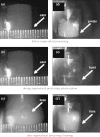Supercritical carbon dioxide: putting the fizz into biomaterials
- PMID: 17464360
- PMCID: PMC1855442
- DOI: 10.1098/rsta.2005.1687
Supercritical carbon dioxide: putting the fizz into biomaterials
Abstract
This paper describes recent progress made in the use of high pressure or supercritical fluids to process polymers into three-dimensional tissue engineering scaffolds. Three current examples are highlighted: foaming of acrylates for use in cartilage tissue engineering; plasticization and encapsulation of bioactive species into biodegradable polyesters for bone tissue engineering; and a novel laser sintering process used to fabricate three-dimensional biodegradable polyester structures from particles prepared via a supercritical route.
Figures







Similar articles
-
Particle seeding enhances interconnectivity in polymeric scaffolds foamed using supercritical CO(2).Acta Biomater. 2010 Mar;6(3):1055-60. doi: 10.1016/j.actbio.2009.08.013. Epub 2009 Aug 9. Acta Biomater. 2010. PMID: 19671454
-
In vitro study of hydroxyapatite-based photocurable polymer composites prepared by laser stereolithography and supercritical fluid extraction.Acta Biomater. 2008 Nov;4(6):1603-10. doi: 10.1016/j.actbio.2008.05.024. Epub 2008 Jun 7. Acta Biomater. 2008. PMID: 18595787
-
Formation of nanoparticles of a hydrophilic drug using supercritical carbon dioxide and microencapsulation for sustained release.Nanomedicine. 2005 Mar;1(1):85-90. doi: 10.1016/j.nano.2004.12.001. Nanomedicine. 2005. PMID: 17292062
-
Biomaterials and Supercritical Fluid Technologies: Which Perspectives to Fabricate Artificial Extracellular Matrix?Curr Pharm Des. 2017;23(26):3759-3771. doi: 10.2174/0929867324666170713145502. Curr Pharm Des. 2017. PMID: 28714408 Review.
-
Biodegradable particle formation for drug and gene delivery using supercritical fluid and dense gas.Adv Drug Deliv Rev. 2008 Feb 14;60(3):411-32. doi: 10.1016/j.addr.2007.02.003. Epub 2007 Oct 11. Adv Drug Deliv Rev. 2008. PMID: 18061302 Review.
Cited by
-
Scaffold-mediated BMP-2 minicircle DNA delivery accelerated bone repair in a mouse critical-size calvarial defect model.J Biomed Mater Res A. 2016 Aug;104(8):2099-107. doi: 10.1002/jbm.a.35735. Epub 2016 Jun 3. J Biomed Mater Res A. 2016. PMID: 27059085 Free PMC article.
-
The future of carbon dioxide for polymer processing in tissue engineering.Tissue Eng Part B Rev. 2013 Jun;19(3):221-32. doi: 10.1089/ten.teb.2012.0361. Epub 2013 Jan 4. Tissue Eng Part B Rev. 2013. PMID: 23289736 Free PMC article. Review.
-
Ultrasonic monitoring of foamed polymeric tissue scaffold fabrication.J Mater Sci Mater Med. 2008 Sep;19(9):3071-80. doi: 10.1007/s10856-008-3445-y. Epub 2008 Apr 5. J Mater Sci Mater Med. 2008. PMID: 18392665
-
Microsphere-based scaffolds for cartilage tissue engineering: using subcritical CO(2) as a sintering agent.Acta Biomater. 2010 Jan;6(1):137-43. doi: 10.1016/j.actbio.2009.07.042. Epub 2009 Aug 4. Acta Biomater. 2010. PMID: 19660579 Free PMC article.
-
Characteristics of lipid micro- and nanoparticles based on supercritical formation for potential pharmaceutical application.Nanoscale Res Lett. 2013 Sep 13;8(1):386. doi: 10.1186/1556-276X-8-386. Nanoscale Res Lett. 2013. PMID: 24034341 Free PMC article.
References
-
- Alavi S.H., Gogoi B.K., Khan M., Bowman B.J., Rizvi S.S.H.Food Res. Int 321999107–118.10.1016/S0963-9969(99)00063-0. - DOI
-
- Arora K.A., Lesser A.J., McCarthy T.J.Macromolecules 3119984614–4620.10.1021/ma971811z. - DOI
-
- Barry J.J.A., Silva M.M.C.G., Shakesheff K.M., Howdle S.M., Alexander M.R.Adv. Funct. Mater 1520051134–1140.10.1002/adfm.200400562. - DOI
Publication types
MeSH terms
Substances
Grants and funding
LinkOut - more resources
Full Text Sources
Other Literature Sources

